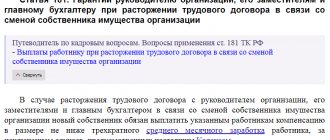Situations where companies completely cease their activities are a common occurrence today. And perhaps the most difficult moment in this entire procedure is the dismissal of working citizens. Reduction of staff in connection with the complete liquidation of an enterprise must be carried out strictly in accordance with the procedure prescribed by law. If the sequence of actions is not followed, additional financial sanctions may be imposed on the employer by a court decision.
Elimination and reduction: differences
How is liquidation different from downsizing?
Before you begin to consider the procedure for terminating employment with employees, it is advisable to determine the difference between dismissal during the liquidation process, as well as simply reducing staff due to the difficult financial situation of the company.
The main difference is that upon liquidation of a company (complete termination of a legal entity or the activities of one of its regional branches), all employees without exception are subject to dismissal. This list even includes socially protected categories of citizens (pregnant women, those on maternity leave, single mothers, disabled people and others). At the same time, the law defines a clear sequence of actions for how such a reduction should occur.
The procedure consists of the following steps:
- A decision is made that the company (branch) will be liquidated. Here you need to understand that a change of name or re-profiling in connection with a merger with another company is not liquidation and this term should not be used here. The decision must be public and formalized in accordance with the established procedure.
- The trade union is informed. The law obliges the employer to inform the existing trade union in the company three months before the date of the decision to liquidate comes into force. This is done in writing.
- Employees are notified. Information about upcoming dismissal due to the start of liquidation is provided individually to each employee. This is done in writing (under signature). This is carried out at least two months before the date of termination of the employment contract. Minor exception regarding notification. Employees who have entered into fixed-term employment contracts for a period of less than 2 months are notified 3 days in advance, and seasonal workers must be notified 7 days in advance. Refusal to sign the notice does not change anything. The employer will just have to formalize it correctly (draw up an act of refusal to sign the notice).
- Report to the employment service. Considering that not all employees will be able to immediately find a new job, the state, represented by the employment service, must have information about the upcoming unemployed. This is enshrined at the legislative level.
- Formalize the dismissal and make full payments to employees. At the time of termination of the employment relationship, the employer is forced to make a full settlement with the employees, issue them with the appropriate dismissal documents and work books.
- Inform the military registration and enlistment office and the FSSP. This is done after the complete termination of employment contracts at the enterprise.
Remember, violation of the procedure for dismissing employees is grounds for filing a lawsuit and starting a court hearing. And even if you ultimately fire the employee anyway (the company is ceasing to operate), you may need to pay him additional compensation and moral damages.
As for the usual reduction in the number of employees, the mechanism described above can only be applied to socially vulnerable citizens. The remaining categories of employees must be employed at the same enterprise.
Expert opinion
Katerina Sorokina
Expert of the site naimtruda.com
What is this?
Based on Article 61 of the Civil Code of the Russian Federation, the liquidation of a legal entity is considered to be the complete cessation of the enterprise’s activities without the possibility of transferring its rights and obligations to third parties.
Paragraph 1, Article 81 of the Labor Code of the Russian Federation in this case states that liquidation becomes the basis for unilateral termination of the employment contract.
A special feature of this reduction is the employer’s right to dismiss workers of all categories. Including those for whom additional guarantees are prescribed by law. Such employees include, for example, those who have gone on leave, including to care for a child, pregnant women, workers under 18 years of age, and employees on sick leave.
Dismissal procedure
Dismissal procedure during liquidation
The key point in termination of employment is the dismissal of the employee. During the liquidation of a company, such a moment may occur for the following reasons.
The employee “waited” for the day when, according to the notice, he was to be fired. In this case, the employer is obliged:
- calculate and pay the employee all wages due to him;
- pay compensation in money for all remaining unused vacations;
- pay severance pay in the amount of two weeks' average earnings;
- issue a properly executed work book;
- at the request of the employee, provide a copy of the order on the basis of which the employment relationship with him was terminated;
- if an employee is on the labor exchange and is unable to find a job, compensate the employee’s average earnings, but no more than two months from the date of dismissal (in some cases three months).
The employee independently decided to leave “early.” Here it is necessary to separate early dismissal due to reduction (the employee has the right to write a corresponding statement and not wait for the end of the two-month period) with payment of the benefits due to him or dismissal at his own request or by agreement of the parties.
Often the latter option is initiated by employers themselves in order to reduce waiting time, as well as reduce the level of paperwork during the dismissal process. As an incentive factor, they usually offer one-time payments in the amount of two salaries (average monthly earnings).
Remember, each employee makes his own decision on how to quit based on his current situation. For example, if you find a new job, what's the point of waiting another two months if you can end your employment relationship in one day and still receive a solid level of compensation for it.
Don’t forget, no matter what method of dismissal you choose, the employer must still issue a work book, a dismissal order, and pay the salary due to the employee, pay for unused vacations and other monetary benefits required by law and the collective agreement on the last day of your work. This is done on the last day of work or on the next day of payment of wages.
Certain categories of workers

It is always clear how the reduction of the company's management is carried out, because... There are practically no individual situations here. However, in other cases, not all people may be fired.
There are some categories of workers who do not fully fall under the general rules - they can be laid off, but only with the subsequent selection of a new job.
Among such workers the following categories are distinguished:
- Women who are pregnant or have a child under three and under six years of age. If the child is not yet three years old, the woman is most likely on maternity leave. If his age is from three to six years, but there is still a need for maternity leave, this must be confirmed by appropriate documentation.
- Single mothers who have a child under the age of fourteen or who has a disability. Single mothers are:
- women who do not have a husband, who have a child’s birth certificate that does not contain the father’s name or, at the request of the mother, has a corresponding mark;
- widows;
- women who are divorced and raising a child (the condition of providing alimony is not taken into account).
- Single fathers (the mother may undergo long-term treatment) or adoptive parents.
- Workers who have not reached the age of majority. Here, certain work must be carried out with employees of the service dealing with children’s affairs, namely, obtaining their consent.
Employee notification
The legislator provided that all employees must be personally notified of the impending cessation of the company's activities and dismissal due to reduction. If the company is facing complete liquidation, such personal notices do not offer the employee any positions. He is simply informed that information about the liquidation will be transferred to the nearest employment center.
By the way, when a reduction in staff or numbers is simply carried out, the employer is obliged to offer the employee all the vacancies available at the enterprise that, by profession, education, and qualifications, can be filled by him. In fact, this and the need for mandatory employment of socially protected employees is the key difference between complete elimination and partial reduction in numbers.
Documenting
Documentation is an important stage of dismissal during liquidation of an enterprise
In the process of implementing the procedure for reducing employees in the event of liquidation of an enterprise, certain documents must be drawn up at each of its stages. In chronological order, this list includes:
- Documents on the beginning of the liquidation procedure. This may be the minutes of the general meeting of shareholders, a decision of the owners in the form of an order, a resolution, or a court decision on the liquidation of the company.
- Union notification. At this stage, a regular letter is prepared in which the head of the company (an authorized person) informs the trade union in any form about the decision made to liquidate and subsequent dismissal of workers. It must necessarily have an originating number and registration date, signed by an authorized manager.
- Employees are notified. The notice of reduction is also in any form. It is addressed to each employee personally, must have an originating number and registration date, describe the grounds for dismissal, compensation due to the employee, and have the date when the employment relationship will be terminated. Signed by the head of the company or, on his behalf, by an employee of the personnel department. It is prepared in two copies, one of which is given personally to the employee, the other remains in the company’s files.
- Employment service notification. In this case, you can inform this government body with a simple letter in any form, providing a list of employees by position that will be reduced or in the prescribed form (addition to government decree No. 99 of 1993).
- Documents for the day of dismissal. This list includes a properly completed work book, a copy of the dismissal order, and a pay slip for payment of wages. Additionally (for the employment service), a statement of wages received for a six-month (annual) period may be required. The employee also has the right to demand a copy of the documents that became the basis for his dismissal.
- Other documents. Acts, minutes of meetings, official letters, memos that are generated during the execution of various procedures and processes related to the dismissal procedure, which in the future can become the evidence base for confirming certain actions, must be drawn up for each fact (event) in a timely manner and signed by authorized persons.
Remember, documenting the process of liquidation and dismissal of employees is a very important process, which can both speed up and slow down the overall liquidation procedure and the level of amounts required to be paid to employees.







